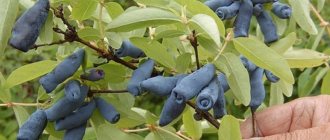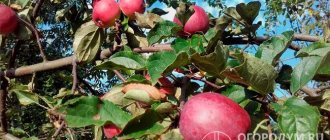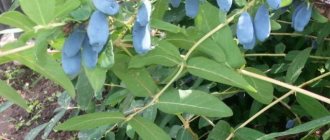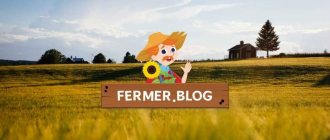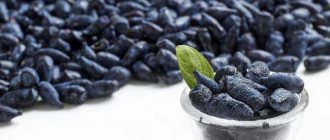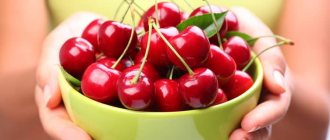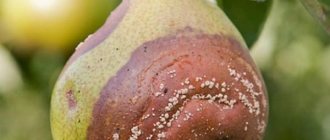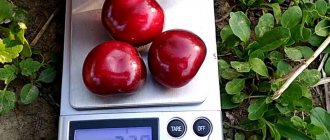History of selection
The variety in question can be found in specialized nurseries under the name “2-24”. It was brought out back in Soviet times, at the Siberian Horticulture Research Institute named after. M. A. Lisavenko. The culture was obtained due to a spontaneous mutation of the plant as a result of cross-pollination of Kamchatka honeysuckle. The variety was included in the State Register in 1989. Recommended for cultivation in the Northwestern region.
Did you know? Due to the fact that the honeysuckle bark peels off and lags behind the trunk, it is popularly called “shameless.”
Botanical description
Botanical description of the culture:
- the bush is large, in comparison with other varieties, reaches a height of 1.2–1.4 m, less often 1.8–2 m;
- the crown is massive, highly thickened, and has the shape of a regular ellipse;
- shoots are thin, without pubescence, young shoots are colored light green, old shoots are brick brown;
- on old growths the bark peels off;
- the foliage has the shape of a regular oval, pointed at the ends, and green;
- flowers are small, almost colorless, formed in the leaf axils of 2 pieces;
- berries are medium-sized, weighing 0.75–0.8 g, spindle-shaped;
- the fruit is colored inky purple, covered with a bluish coating, which gives it a blue tint.
Characteristic
Before you start cultivating a crop on your site, you need to consider in detail its main characteristics regarding resistance to negative environmental factors, as well as to diseases and pests. Based on this information, you should make a list of advantages and disadvantages, after considering which you can choose the most suitable location on the site and organize proper care.
Frost resistance and drought resistance
The culture tolerates temperature drops down to -40...-45°C without shelter. The state of vegetation is negatively affected by temperature changes - warming in winter, cooling in summer. The vegetation is not resistant to drought, but it also does not tolerate high humidity. The crop requires moderate soil moisture, ranging from 50–60%. The crop exhibits increased resistance to diseases and pests.
Did you know? An extract from fragrant flowers and honeysuckle berries is used in the creation of perfumes. In particular, this is practiced by such well-known brands as Adidas and Avon.
Fruiting, productivity
The crop begins to bear fruit in the third year of life on the site. The average productivity of the variety is 20–25 years, subject to rejuvenating pruning every 12–15 years. This variety is characterized by early ripening. Depending on how warm the spring was, the first berries appear between June 10 and June 25.
On average, you can collect 1–1.5 kg of berries from a bush; under favorable weather conditions and proper agricultural practices - 3 kg. The highest yields are observed in the 12th year of life of the vegetation on the site. The berries have good taste. Tasting score: 4.5 points out of 5 possible.
The taste is harmonious, balanced, sour-sweet, slightly tart. The sugar content in the pulp is 6.4%, so the acid is felt weakly. The berries have a characteristic pleasant fruity aroma. Honeysuckle fruits are not only tasty, but also healthy. Their consumption will help strengthen the immune system, since the content of ascorbic acid in 100 g of fresh berries is 17 mg.
Advantages and disadvantages of the variety
The main advantages of the Blue Bird:
- frost resistance;
- immunity to diseases and pests;
- ease of care;
- ability to adapt to different climatic conditions;
- long fruiting period;
- universal use of berries;
- early ripening of the crop.
Disadvantages of the variety:
- need for pollinating varieties;
- sensitivity to temperature changes;
- demands on the level of soil moisture;
- relatively low yield.
Differences from other varieties and hybrids
Comparison of Bluebird with other early ripening honeysuckle varieties:
| Variety | Berry weight, g | Taste | Berries shape | Productivity, kg/bush |
| Blue bird | 0,75–0,8 | Sourish-sweet | Fusiform | 1–1,5 |
| Amazon | 1,1 | Sweet and sour, with slight bitterness | Pitcher-shaped | Up to 1.5 |
| Baikalovskaya | 1 | Sweet | Oblong | 1,5–2,5 |
| Viola | 1 | Sweetish-sour, with bitterness | Extended | 1,9–3 |
Pollinators
Like all varieties of honeysuckle, the crop in question is self-sterile. This means that another pollinating variety needs to be planted next to it. When cultivating such plants, they usually buy 2 varieties in pairs at once.
The best varieties in this regard are the following:
- Cinderella;
- Moraine;
- Titmouse;
- Kamchadalka;
- Start;
- Blue spindle.
It is best to plant 3 varieties on the site at once. If space allows, then organize plantings of 10–15 bushes at once. This will make it possible to get larger, sweeter fruits.
The main carriers of pollen are insects. During the flowering period, you need to take care of attracting them to the site. To do this, spray honey syrup (40 g per 10 liters of water) on the leaf and the outside of the buds (so as not to wash off the pollen).
Popular varieties of honeysuckle
Fruit perennials with sweet berries bluish from a waxy coating are usually found in gardens. Edible honeysuckle, unlike other species, is an early-ripening crop with increased winter hardiness. Almost all of its varieties are self-sterile, so for cross-pollination it is necessary to plant at least two different specimens that form buds at the same time. It is more advisable to use 4-5 different pollinators, placing them at a distance of 2 m.
Fruiting in this species occurs on one-year-old wood, and the yield increases gradually. It reaches its maximum by 7-8 years of growth. Over the next ten years, yields remain stable. It is recommended to replace bushes every 25 years.
When choosing a productive variety, farmers are advised to be guided by 4 indicators:
- ripening period,
- productivity,
- winter hardiness,
- taste characteristics.
To increase the period of consumption of vitamins from the garden, seedlings with different ripening periods are selected. Remontant blackberries make a good company with honeysuckle; there are varieties with and without thorns. With proper care, you can harvest up to 30 kg from one blackberry bush. With such indicators, even a novice gardener will not be left without a berry treat.
The best varieties of edible honeysuckle are hybrids of the Kamchatka type. These include:
- The Bakchay giant is a tall perennial up to 2 m in height. Young shoots grow 60 cm in length. It has an elongated oval crown. The Bakchay giant is valued for its large fruits (up to 1.8 g) with a bluish coating and a significant yield (up to 4 kg). Shedding is average.
The final size of the bush and its fruiting cycle will depend on the climatic conditions of a particular region, the soil composition of the site and maintenance conditions. In order to prevent developmental deviations in time, it is necessary to regularly monitor how honeysuckle grows and the condition of its tillering node. A dry trunk is the first sign of waterlogging of the soil and fungal infection of the root ball.
Landing Features
With proper care, honeysuckle bushes will remain productive for many years, so planting must be approached taking into account all the requirements, of which there are not many.
Basic preparations for cultivation:
- determining the timing of disembarkation;
- selection and pre-planting treatment of soil on the site, as well as planting material.
Deadlines
First of all, you need to take into account the growing season of vegetation - the buds begin to swell already in March, when in most of the territory of the Russian Federation the soil is not yet warmed up well enough. Considering this, it is better to plant at the end of summer.
Important! It is strictly forbidden to plant flowering honeysuckle bushes. Otherwise, the vegetation will not take root.
Selecting a site, preparing holes
To get a good harvest with high taste, you need to choose an area that is most abundantly illuminated by the sun. It can be grown in partial shade, but not in full shade. In addition, care should be taken to provide natural (trees, shrubs) or artificial (buildings, fences) protection from cold northern winds.
Taking these requirements into account, the ideal location would be the southern or southeastern part of the territory, protected from drafts from the north.
There are no requirements in terms of soil quality. The main thing is that it has neutral acidity within the range of 5–7 pH. At the same time, the best yield indicators are observed on light, loose, loamy and sandy loam soils with a high organic content.
An important nuance when choosing a site is the location of groundwater: it should be located at a distance of no closer than 1.5 m to the surface. The culture is demanding of moisture, but does not tolerate waterlogging. For this reason, planting options in lowlands and wetlands are excluded.
They begin to prepare the site in the fall. At this stage, the soil is plowed to a depth of 40 cm. Disinfection is carried out using 3% copper sulfate concentrate (1 liter per 10 m²). A week later, the soil is plowed again to a depth of 20 cm, having previously added 20 kg of manure, 400 g of wood ash and 10 kg of sand to each 1 m². On sandy loam soils, sand is not added.
The wells are also prepared in advance. This must be done approximately 20 days before planting. The honeysuckle bushes in question should not be planted in a row, like raspberries or blackberries, but in a circle: in the center is a pollinator plant, and around 4-5 Bluebird bushes. The distance between plants should be 1.5 m. The size of the holes is 40x40 cm.
Step-by-step preparation of holes:
- Dig holes, taking into account the diagram described above.
- Mix the soil from the hole with 20 kg of compost and 1.5 kg of wood ash.
- Fill the hole 1/3 with nutrient substrate, form a hill about 10 cm high in the center.
- Cover the holes with waterproof material (film or tarpaulin) so that the elevation you have formed will not be washed away by rain before planting the vegetation.
Selection and preparation of planting material
The purchase of seedlings must be carried out in specialized nurseries. Two-year-old plants have the best survival rates. The height of a good healthy seedling should vary between 25–60 cm.
It is advisable to buy plants in containers - the roots of such specimens do not suffer from drying out, as happens with those that were dug up before sale and sold with open rhizomes. A large number of white thin root shoots should be visible on the surface of the earthen coma.
Preparation of planting material begins one day before moving into open ground:
- The seedling is removed from the container. The roots are freed from soil, which is easily removed, then washed under running water.
- Inspect the plant and remove dried shoots if necessary. Roots reaching a length of more than 30 cm are shortened.
- Soak the rhizome for 18–20 hours in a growth accelerator. You can use Zircon. To prepare a solution, add 40 drops of the drug to 1 liter of water.
Planting scheme
Step-by-step planting of vegetation:
- Remove the covers from the pits and pour 5 liters of water into them.
- After absorbing the moisture, make a hole in the center of the hill and place the root system of the seedling in it.
- Spread the rhizome around the entire perimeter of the recess.
- Level the plant so that its root collar is flush with the ground after filling the hole.
- Fill the hole with soil, compacting it periodically.
- Compact the soil in the tree trunk well and add 7–10 liters of water.
- After absorbing the liquid, mulch the area around the bush with compost.
Sawdust should not be used as mulch, as it contributes to soil acidification, which will negatively affect the rate of establishment of the crop in a new location.
Important nuances of growing crops
Honeysuckle is not least valued by gardeners for its undemanding cultivation. Caring for the Blue Bird variety will also not take much time and effort; even beginners can get a harvest. Due to its high frost resistance, the plant does not need shelter for the winter, even in Siberia and the Urals. Bluebirds rarely suffer from diseases and pests. Therefore, care essentially comes down to proper watering and fertilization. You will also need to pay regular attention to pruning, but this is not difficult.
Honeysuckle Bluebird has a good survival rate, quickly adapting to new living conditions
The trunk circle, like that of other berry bushes, in honeysuckle approximately coincides in diameter with the crown. It is maintained in proper form by weeding and clearing of plant debris (fallen berries, fallen leaves, broken branches, etc.). The soil also needs to be loosened, but not too intensively, to a depth of 4–5 cm. Bluebird honeysuckle has many superficial roots that are easily damaged. Ideally, loosening should be carried out after each watering, while simultaneously replenishing the mulch layer as necessary, but if this is not possible, at least 3-4 times per season.
Honeysuckle Bluebird loves water, but categorically does not tolerate it stagnating at the roots
The soil for growing Bluebird honeysuckle should always be moderately moist, but this crop absolutely cannot tolerate soil that looks like a swamp. Therefore, it is important to find a “golden mean”. The frequency of watering is adjusted depending on the weather outside. If the weather is moderately warm and dry, an adult plant needs 10–15 liters of water every 3–4 days. The best time for the procedure is early morning or late evening. Each time after it, it is advisable to mulch the soil. This will help retain moisture for a long time and save time on weeding. Water is used that has settled and heated to a temperature of 22–25ºС.
Mulch in the tree trunk prevents weeds from germinating and at the same time retains moisture in the soil
Don't forget about moisture-recharging watering. If autumn is cool and rainy, it can be neglected. Otherwise, around mid-October, the plant is watered abundantly, spending 30–40 liters of water on an adult bush. This is necessary to prepare for winter.
Recent Entries
5 working ways to use tar in the garden 7 indoor plants that help you get married even in adulthood Indoor plants that can bloom in trouble
If all the necessary fertilizers have been added to the planting hole, the honeysuckle seedling does not need fertilizing for the first two years. The plants are fertilized for the first time during the third season of being in the open ground.
In the spring, as soon as the soil has thawed enough to be loosened, nitrogen-containing fertilizers are applied. Urea, ammonium nitrate, ammonium sulfate (10–15 g) are dissolved in 10 liters of water. An adult plant uses 2–3 liters of fertilizer. Every 3-4 years, in addition, natural products are distributed in the tree trunk circle - humus, rotted manure, compost (15-20 l).
Urea, like other nitrogen-containing fertilizers, stimulates the honeysuckle bush to actively increase green mass
Nitrogen-containing fertilizers are applied exclusively at the beginning of the growing season. At this time, they are very necessary, helping the bush to intensively increase its green mass. But then an excess of nitrogen can lead to the fact that the plant begins to “fatten”; it simply does not have the strength left to form fruit ovaries and ripen the berries; everything will be spent on feeding the leaves.
10–12 days after flowering, the Blue Bird is fed with any complex fertilizer for berry bushes (Agricola, Fasco, Forte, Zdraven, Ogorodnik, and so on). Natural remedies include infusions of dandelion leaves, nettles, and wood ash.
Nettle infusion is a natural source of potassium and phosphorus; these macroelements are necessary for honeysuckle to ripen fruits
The last fertilizing is applied 1.5–2 weeks after harvesting. In order to properly prepare for winter, the plant needs phosphorus and potassium. Fertilizer is applied in liquid form, diluting 25–30 g of simple superphosphate and 15–20 g of potassium sulfate in 10 liters of water. You can also use complex phosphorus-potassium fertilizers (AVA, Osen, Azofoska, Nitrophoska), preparing the solution according to the instructions given by the manufacturer in the instructions.
The Bluebird does not need special shelter from the cold. However, if the winter is expected to be abnormally harsh and with little snow, it is advisable to protect the roots by building a mound of peat or humus 15–20 cm high.
Honeysuckle Bluebird tolerates even severe Siberian frosts without much damage
Video: tips for caring for honeysuckle
An adult honeysuckle bush is distinguished by its ability to intensively branch. Therefore, pruning for this crop is a mandatory procedure. The bush is thinned out annually so that it is evenly illuminated by the sun. Otherwise, the entire crop will ripen on its periphery. The first time this procedure is carried out is for a plant that has reached the age of 4–5 years. A properly formed bush consists of 15–18 branches.
Pruning Bluebird honeysuckle is carried out either in early spring, before the active growing season begins (approximately mid-March), or towards the end of October, when sap flow stops and the plant “hibernates”. In both cases, the temperature outside should be above 0ºC.
The basic rule for pruning honeysuckle is not to remove shoots to the point of growth. It is imperative to leave a “stump” 25–40 cm high. It does not form basal shoots, like many other berry bushes, so “stumps”, if necessary, can be used to form replacement shoots.
The honeysuckle bush is thinned out so that it is more or less evenly illuminated and warmed by the sun
Thinning pruning promotes a bountiful harvest. Achieving maximum performance is possible only if the growth of shoots per season is at least 15–20 cm. And this requires sufficient nutrition, sunlight and warmth. A third of the existing skeletal branches are left untouched; the developed lateral shoot that is located above the rest is cut off from the rest.
Anti-aging pruning is first carried out when the plant reaches 12–14 years of age. First of all, they get rid of the oldest shoots, which will definitely no longer bear fruit. This applies to all branches older than 10 years. The most poorly located ones are also cut off - those growing too low (the berries that ripen on them lie on the ground), twisted shoots directed deep into the crown. Do the same with broken and dried ones.
If the honeysuckle bush has not been pruned for a long time, you cannot cut off most of the green mass at one time. This is a very strong stress for the plant, from which it may not recover. It is better to gradually get rid of the 3-5 oldest branches per year over several seasons.
Most of the Bluebird crop ripens at the ends of the shoots. Flower buds are concentrated mainly on the upper third of the branch. Therefore, cutting them unless absolutely necessary is strongly recommended.
For pruning, use only sharply sharpened and disinfected tools (secateurs, scissors of a suitable size). To sterilize them, they can be kept, for example, in a deep purple solution of potassium permanganate. If the cut diameter exceeds 0.5 cm, the “wounds” are covered with garden varnish or covered with oil paint in 2–3 layers. It is advisable to first wash them with a 2% solution of copper sulfate.
The tool for cutting honeysuckle must be sharp and disinfected
Video: how to prune honeysuckle correctly
Bluebird honeysuckle is extremely rarely affected by diseases. Nevertheless, for prevention - before the leaves bloom and after fruiting ends - you can spray the plant with a solution of any fungicide. Copper-containing preparations effectively destroy the vast majority of pathogenic fungi. The most common of them are Bordeaux mixture and copper sulfate, but there are also many more modern means (Abiga-Pik, Skor, Horus, Topaz, Kuproksat).
Bordeaux mixture is one of the most common fungicides; it can be purchased at any specialized store or made independently.
Pests also for the most part bypass the Bluebird. Effective prevention is to dust the bush once every 1.5–2 weeks with sifted wood ash, colloidal sulfur, and crushed chalk. Most insects are effectively repelled by infusions with a pungent odor. As raw materials you can use onion or garlic arrows, marigold leaves, tomato tops, wormwood, orange peel, tobacco chips, hot peppers and so on. The frequency of processing is once every 5–7 days.
Wormwood produces phytoncides that effectively repel most pests
Rules of care
Even a novice gardener can cope with growing this crop without any problems, since it requires minimal care. Due to its high resistance to diseases, pests and cold, it does not require shelter for the winter even when cultivated in the Urals and Siberia, and does not require additional preventive spraying with chemicals.
The main agrotechnical measures that should be paid attention to when growing honeysuckle:
- watering;
- soil care;
- fertilizing;
- sanitary and anti-aging pruning.
Planting and caring for Bluebirds
The bluebird, even among honeysuckle, is distinguished by its exceptional ability to adapt to the most unfavorable conditions. It is undemanding to the soil and can do without fertilizing. The only thing that must be taken into account when growing honeysuckle is that although it is a moisture-loving crop, excess moisture can be detrimental to its roots, so waterlogging of the soil should be avoided in every possible way.
Despite the relatively short growth, due to the large crown, Bluebird seedlings should be planted quite widely - the distance between them should be at least 1.5 m. For planting, it is better to choose a sunny place, protected from cold winds. In partial shade, ripened berries will be too sour, and in the shade they may not set at all.
For planting, dig a hole with dimensions of 50x50 cm and a depth of at least 40 cm. Humus is placed on its bottom, filled with phosphorus and potassium fertilizers and mixed with 2-3 cups of wood ash. A layer of fertilizer is sprinkled with ordinary soil on top to prevent contact of the roots of the seedling with fertilizers at first, and the roots of the honeysuckle seedling are laid on this soil.
The roots are sprinkled with earth on top, which needs to be slightly compacted near the trunk of the seedling, then the circle around the trunk is watered generously with water. When the ground absorbs some of the moisture, the tree trunk circle is mulched to conserve moisture and prevent the growth of weeds.
Honeysuckle seedlings need to be planted while they are dormant - in early spring or autumn. For the first 3-4 years, seedlings grow slowly, but after fruiting begins, growth accelerates.
It begins to bear fruit from the third year after planting. The fruiting period is 20-25 years, but only if the bush is regularly rejuvenated: removing old 7-8 year old branches and replacing them with young 2-3 year old shoots.
The crown of the Bluebird tends to grow thickened. There is no particular problem in this, but in order to obtain the maximum yield, it still needs to be formed, thinning out a little. Also, for normal growth and vegetation of honeysuckle bushes, they need to be thoroughly fed once every 2-3 years, adding humus and wood ash.
Harvesting and storage
The fruits begin to fall off as they ripen. In order not to lose part of the harvest, at the moment when the berries begin to turn dark, a film is spread under each bush. 2 weeks after this, the plants are simply shaken so that all the fruits fall off. The harvest is immediately sorted, selecting damaged specimens.
Whole berries are placed in small containers with low sides, lined with paper, in one layer. Store in the refrigerator for no more than 3 days. To increase the shelf life of the crop, you can freeze the fruits or send them for processing. They make delicious jams, preserves, pastilles and much more.
Application
This healthy product should be on the menu of people who care about their health and figure. This is a real treasure for cooks - these sweet and sour berries can be used to make juices, jams, wines and liqueurs used in the fight against autumn colds. Of course, you can eat the berries fresh, as an addition to salads, jellies, or ice cream. They keep well frozen or dried. The vast majority of processed fruits retain their composition up to 80%.
Reproduction methods
Reproduction of the honeysuckle variety in question can be carried out in several ways:
- Green cuttings - cut from the shoots of the current year. Harvesting of material begins after the plants have flowered and the first berries begin to form. The strongest growths are selected; they are cut and then divided into several parts 12 cm long. Each cutting should have 3 buds. For a day, the prepared material is soaked in “Kornevin” (20 drops of the drug are added to 1 liter of water). After this time, the cuttings are planted in the ground and covered with plastic bottles with the bottom cut off. Periodically, the plantings are watered and ventilated. After a month, the covers can be removed.
- Woody cuttings - they are cut at the end of September - beginning of October after the leaves have fallen. Select shoots of the current year with several internodes (2–5 pieces). Wrap the planting material in burlap or paper, dig in to a depth of 10 cm and cover with leaves. In spring, they are planted in open ground at an angle of 45° so that only 1 internode remains above the surface.
- By dividing the bush - manipulation is carried out before the buds swell or in the fall after the leaves fall. They dig up bushes that are 3–5 years old. Using pruning shears, divide each plant into several parts. The resulting bushes are planted in prepared holes.
Honeysuckle jam
Ingredients:
- 0.5 kg granulated sugar;
- 1 kg of fresh berries.
Preparation:
- The berries should be washed, pitted, sprinkled with granulated sugar and mixed.
- Pass the mixture through a meat grinder or grind in a blender.
- Then cook over medium heat until all the sugar has dissolved.
- Hot jam must be poured into pre-sterilized jars and rolled up. Store in a cool place.
Diseases and pests
As a preventative measure, you can spray the bushes before the start of the season and at the end of it with a 1% solution of Bordeaux mixture. During the active growing season, to eliminate the risk of disease and pests, especially with high humidity, it is necessary to dust the leaves and soil with wood ash every 10 days.
Did you know? Honeysuckle fruits are an excellent aphrodisiac. They not only increase libido, but also help improve erectile function in men.
Among the diseases, if not properly cared for, plants of the variety in question can be affected by powdery mildew . When the first symptoms appear - a whitish coating on the surface of the leaves and their gradual curvature - it is necessary to remove all infected parts, then treat the bushes with Fitosporin according to the instructions.
Among the pests, the crop can be affected by mites and aphids . When parasites appear, you must immediately remove the lesions, loosen the soil to a depth of 5 cm, then dust the plants and soil with tobacco dust or spray with Fitoverm.
So, the Bluebird honeysuckle variety has many advantages. It is easy to care for and promising in commercial activities. When growing it, the main attention should be paid to the quality of watering.
Description of the honeysuckle variety Serotina
Honeysuckle Serotina (or Sirotina, as some gardeners call it), also known as Primorskaya, has a very remarkable description. This is a beautiful flowering plant that can decorate any area. Below are basic data from the history and characteristics of the variety.
History of selection
Decorative honeysuckle Serotina (Lonicera periclymenum serotina) has an English synonym “late Dutch honeysuckle” - “late Dutch honeysuckle”. The plant can often be found in botanical gardens in the Netherlands. However, according to European sources, the birthplace of the culture is France.
It should be noted that the popular name “honeysop” has absolutely nothing to do with it. In fact, these plants belong to different species of the Honeysuckle genus. Honeysuckle (Lonicera caprifolium) is a separate species, and Serotina is a cultivar belonging to the species Lonicera periclymenum.
Did you know? Among all types of honeysuckle, only a few varieties are edible. Some of the varieties are even poisonous, for example, the well-known “wolf berry”.
Appearance, characteristics of the vine
Honeysuckle Serotina has the appearance of a decorative climbing vine. The vines reach an average height of 5 m. The plant is a fast-growing one - the vines grow 1-2 m per year. The young branches are “bare”, without pubescence. The shoots are medium leafy. The leaves are large, up to 6 cm in length, egg-shaped, matte green in color. By autumn, the leaf blades turn yellow.
The main advantage of the Serotina variety is its flowers. The buds are tubular in shape. The color of the outer side of the petals is dark red. The inside of the flower is white in a cream shade. There is a pronounced aroma, similar to the smell of a blooming linden tree. The plant blooms from June to September. The berries are inedible, but have decorative value. The fruits are up to 1 cm in diameter, slightly elongated in shape, bright red in color.
Did you know? You can distinguish edible honeysuckle berries from inedible ones by color: black and blue ones can be eaten, but red and orange ones cannot.
Advantages and disadvantages of the variety
- The Serotina variety has many positive aspects:
- fast growing;
- decorativeness;
- fragrant flowering;
- ease of care;
- resistance to most diseases and pests.
- However, there are also disadvantages:
- average frost resistance;
- low resistance to powdery mildew.
